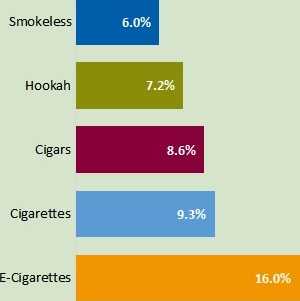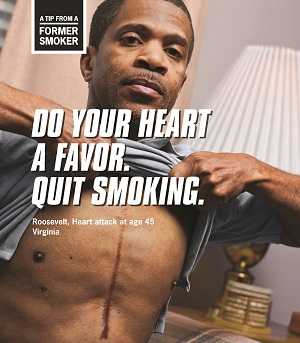Tobacco Use
Extinguishing the Epidemic
At A Glance 2016
Tobacco use is the leading cause of preventable disease, disability, and death in the United States. Every day, more than 3,800 youth younger than 18 years smoke their first cigarette. Each year, nearly half a million Americans die prematurely of smoking or exposure to secondhand smoke. Another 16 million live with a serious illness caused by smoking.
The Centers for Disease Control and Prevention (CDC) is at the forefront of the nation’s efforts to reduce deaths and prevent chronic diseases that result from tobacco use. The agency and its partners promote tobacco control interventions, including smoke-free environments, programs to help tobacco users quit, actions to prevent youth from starting to use tobacco, and steps to eliminate tobacco-related health disparities in different population groups.
Public Health Problem
Cigarette smoking rates for both adults and youth are less than half what they were in 1965. Nearly 60% of the US population is covered by state or local laws that protect nonsmokers from exposure to tobacco smoke in public places, such as worksites, restaurants, and bars. Yet even with this progress, nearly 40 million adults still smoke cigarettes.
Nearly 9 in 10 adults who are current cigarette smokers first tried a cigarette before age 18. Today, about 4.7 million middle and high school students use at least one tobacco product, such as e-cigarettes, hookah, and conventional cigarettes.
Cigarette smoking damages nearly every organ of the body. Smokers miss more work, visit a doctor more often, are hospitalized more often, and die 10 to 12 years earlier than nonsmokers. Each year, the United States spends nearly $170 billion on medical care to treat smoking-related disease in adults.
Secondhand smoke exposure also causes many serious health problems—such as heart disease, stroke, and lung cancer—in nonsmoking adults. In children, secondhand smoke can cause sudden infant death syndrome, acute respiratory infections, ear infections, and more frequent and severe asthma attacks. About 25% of nonsmoking Americans (58 million people) are exposed to secondhand smoke, including 15 million children aged 3 to 11 years.
In 2014, the US Department of Health and Human Services (HHS) published a 50th anniversary Surgeon General’s Report on smoking and health. This report outlines strategies to end the smoking epidemic and recommends the use of comprehensive tobacco control programs. The goal of these programs is to use coordinated activities to:
- Prevent youth and young adults from starting to use tobacco.
- Promote quitting.
- Eliminate exposure to secondhand smoke.
- Identify and eliminate tobacco-related health disparities.
Hard-hitting media campaigns are an important part of comprehensive tobacco control programs because they provide vital health information to tobacco users and offer incentives and encouragement for quitting. These campaigns are also effective in preventing people from starting to use tobacco.
Annual Deaths from Smoking, United States
Note: Average annual number of deaths for adults aged 35 or older, 2005-2009.
Source: 2014 Surgeon General’s Report, Table 12.4, page 660 [PDF – 2.7 MB].
CDC’s Response
The National Center for Chronic Disease Prevention and Health Promotion (NCCDPHP) works in four key areas or domains: epidemiology and surveillance, environmental approaches, health care system interventions, and community programs linked to clinical services. This comprehensive approach supports healthy choices and behaviors, makes healthier options more available, and helps Americans better manage their health.
CDC works with partners—such as public health agencies, other federal agencies, academia, community organizations, businesses, and faith-based groups—to improve the nation’s health by reducing the use of tobacco products. With $210 million in FY 2016 funding, CDC’s Office on Smoking and Health supports these efforts by working in all of NCCDPHP’s four domains.
Epidemiology and Surveillance
CDC conducts and coordinates surveillance, laboratory, and evaluation activities related to tobacco use and its effect on health. For example, CDC:
- Monitors changes and trends in the use of tobacco products.
- Assesses tobacco knowledge, attitudes, and behaviors using surveys of adults and youth.
- Evaluates the effectiveness of comprehensive tobacco control and prevention programs and policies.
- Publishes studies to answer important questions about tobacco use and tobacco control.
- Evaluates additives and chemical constituents of tobacco products and secondhand smoke.
Environmental Approaches
Comprehensive state tobacco control programs reduce smoking rates, as well as deaths and diseases caused by smoking. They also save money and are a “best buy” in public health. States with strong tobacco control programs have earned significant returns on their investment. For example, California’s program saved the state $55 for every $1 invested in tobacco control over 20 years, mostly in health care costs to treat smoking-related illness.
CDC supports comprehensive tobacco control programs in all 50 states, the District of Columbia, 8 US territories or jurisdictions, and 12 tribal organizations. This support includes the evidence-based guide, Best Practices for Comprehensive Tobacco Control Programs. The agency also funds 8 national networks to reduce tobacco use among specific populations.
In addition, CDC manages HHS’s Interagency Committee on Smoking and Health, which coordinates research programs between federal, state, local, and private agencies. CDC also is helping the US Department of Housing and Urban Development adopt smoke-free policies for the nation’s 1.2 million public housing units, which house more than 2 million people.
Health Care System Interventions
CDC supports efforts to help tobacco users quit through the health care system. The agency works with partners, including payers, purchasers, and providers in both private and public health systems, to:
- Expand access to and use of tobacco cessation treatment in accordance with the US Public Health Services’ Clinical Practice Guideline, Treating Tobacco Use and Dependence: 2008 Update.
- Remove barriers to covered cessation treatments, such as cost-sharing and prior authorization.
- Promote use of covered cessation treatments by tobacco users.
Community Programs Linked to Clinical Services
Promoting Quitline Services
Quitlines are telephone-based services that help tobacco users quit by providing callers with counseling, practical information on how to quit, referral to other cessation resources, and, in some states and for certain populations, FDA-approved cessation medications. CDC supports state quitline services in all 50 states, the District of Columbia, and 2 US territories. The agency works to expand the reach of these services, especially in populations with high rates of tobacco use. CDC promotes 1-800-QUIT-NOW, which connects callers nationwide to free services from their state quitlines.
CDC also promotes the national Asian Language Quitline, which provides services in Chinese, Korean, and Vietnamese, and the national Spanish Quitline (1-855-DEJELO-YA), which connects callers to Spanish-language services available from state quitlines.
Communicating Information to the Public
CDC translates research into practice by educating the public, policy makers, health professionals, and partners about the dangers of tobacco use. For example, the agency developed the Tips campaign to highlight stories of people living with disease caused by tobacco use and exposure to secondhand smoke.
CDC also uses social media to reach specific audiences, including youth and young adults, with information and links to resources to help them quit. The agency creates digital content and traditional media products that can be used by the public, partners, and policy makers.
Promoting Action Through Partnerships
To advance tobacco prevention and control, CDC works with partners such as the American Cancer Society, American Heart Association, American Lung Association, Americans for Nonsmokers’ Rights, Truth Initiative, Campaign for Tobacco-Free Kids, Robert Wood Johnson Foundation, and the North American Quitline Consortium.
Related Materials
Fast Facts
- Tobacco use kills nearly 500,000 Americans each year.
- Nearly 40 million US adults still smoke cigarettes, and about 4.7 million middle and high school students use at least one tobacco product, including e-cigarettes.
- Nicotine is highly addictive and may harm teens’ developing brains. No tobacco product is safe for youth to use.
- About 25% of nonsmokers are exposed to secondhand smoke where they live, work, or play.
- CDC supports comprehensive tobacco control programs in all 50 states, the District of Columbia, 8 US territories or jurisdictions, and 12 tribal organizations.

E-Cigarette Use Rising
Among Young People
Youth and young adults are increasingly using electronic nicotine delivery systems, including e-cigarettes, vape pens, e-hookah, and similar devices. In fact, more teens now use e-cigarettes than conventional cigarettes.
In 2015, about 5 in 100 middle school students (5.3%) reported using e-cigarettes in the past 30 days—an increase from 0.6% in 2011. Also in 2015, 16 in 100 high school students (16.0%) reported using e-cigarettes in the past 30 days—an increase from 1.5% in 2011.
All tobacco product use, including e-cigarettes, poses dangers to youth. Most e-cigarettes contain nicotine, which is a highly addictive drug. Adolescence is a critical period for brain development, and nicotine exposure during this time can cause addiction, might harm brain development, and could lead to sustained tobacco product use among youth.
Tobacco Use in the Past 30 Days
Among High School Students

Tips Campaign Motivates
Millions to Try Quitting
In 2012, CDC launched the first-ever federally funded, national tobacco education campaign, called Tips From Former Smokers. The campaign features real people who tell their stories of living with serious health problems from smoking or secondhand smoke exposure.
The Tips campaign connects smokers with resources to help them quit, including a free national quitline (1-800-QUIT-NOW). It also encourages doctors, nurses, dentists, pharmacists, and other health care providers to help their patients quit for good. This groundbreaking campaign has motivated at least 5 million Americans to try to quit smoking, and at least 400,000 smokers have quit for good since 2012.
The Tips campaign is also highly cost-effective. Interventions that cost up to $50,000 for each year of life they save are considered to be cost-effective. The Tips campaign cost just $393 per year of life saved.

Future Directions
CDC will continue to work with decision makers, partners, health officials, and the public to end the tobacco epidemic by:
- Supporting comprehensive state tobacco prevention and control programs.
- Educating the public about the harms of tobacco use, including through paid media campaigns like Tips.
- Supporting health systems to improve cessation insurance coverage, remove barriers to evidence-based cessation treatments, and promote use of covered treatments.
- Reducing tobacco-related health disparities through national networks working to reduce tobacco use among specific populations.
- Supporting state quitlines and maintaining and promoting 1-800-QUIT-NOW, 1-855-DEJELO-YA, and the Asian Language Quitline.
- Page last reviewed: January 30, 2017
- Page last updated: January 30, 2017
- Content source:



 ShareCompartir
ShareCompartir